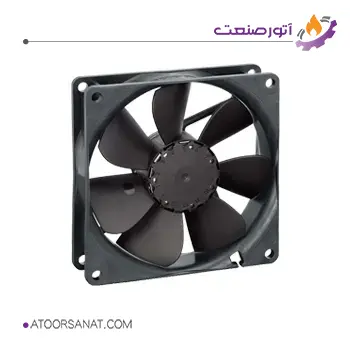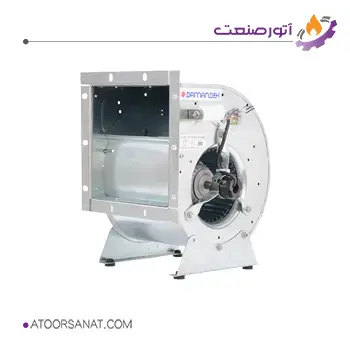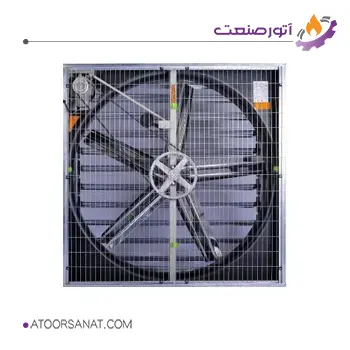Fans

Types of Industrial and Household Fans
Fans play a crucial role in ventilating various industrial and domestic environments. In fact, in some spaces, it’s impossible to have a comfortable atmosphere without using them. Manufacturers produce a variety of fans with unique features to ensure that their ventilation capabilities (flow rate, pressure, etc.) are suitable for each environment.
Generally speaking, fans operate in two primary ways: either the inlet and outlet airflow directions are the same (axial fans), or they are perpendicular (centrifugal fans). Each of these main types has further subcategories.
Fans can be broadly categorized into two groups based on their application: household and industrial. Industrial fans are more powerful in terms of their operational capacity. In contrast, household fans are smaller in size and only have enough capacity to ventilate a small area. Additionally, they must have an appealing appearance to complement the home’s aesthetics.

Features:
- Country of Origin: Iran
- Motor Power: 26 to 1200 Watts

Features:
- Country of Origin: Iran
- Body Material: Metal – Galvanized

Features:
- Country of Origin: Iran
- Body Material: Galvanized
- Applications: For poultry farms, factories, etc.
Industrial Fans
Industrial fans come in a wide range of models and are considered the most powerful fans on the market. These fans can operate for long hours and move large volumes of air. Moreover, there are several different types of industrial fans, with the most important being:
- Simple propeller fans:
These are the most common and affordable types of industrial fans. They are typically made of aluminum, making them resistant to corrosion. Their simple design allows for easy wall or window installation. The airflow generated by these fans depends on the size of the propeller and its rotational speed.
- Industrial axial flow fans:
As the name suggests, axial flow fans have blades that rotate parallel to the airflow. They are highly efficient in moving large volumes of air and are suitable for various applications. These fans are also resistant to corrosive gases and high temperatures.
- Centrifugal fans:
Centrifugal fans have a unique design with a cylindrical impeller and radially mounted blades. The impeller is housed in a volute casing, which directs the airflow perpendicular to the axis of rotation. These fans can be further classified based on the shape of their blades: forward curved, backward curved, and radial. The number and angle of the blades significantly impact the fan’s performance.
- Ceiling fans:
Ceiling fans are specifically designed for ventilation in areas like warehouses and poultry farms. They can be either simple propeller-type fans installed on the roof or more complex, dome-shaped units. Their elevated position allows them to effectively remove hot air.
- Duct-mounted fans:
Duct-mounted fans use a combination of blades and a volute casing to create a high-pressure airflow. They are suitable for applications requiring high-temperature air movement, such as in metal smelting and glass manufacturing plants.
- Cross-flow fans:
Cross-flow fans have a unique design with a larger inlet than outlet, creating a Venturi effect that increases airflow. They are often used as blowers in applications where heated air is used for drying or curing processes.
- Belt-driven fans:
Belt-driven fans use a belt to transmit power from the motor to the impeller. This design allows for flexibility in motor selection and can accommodate larger fan sizes. However, belt-driven fans tend to be noisier than direct-drive fans.
The above models are among the most commonly used types of industrial fans and are employed in various industries. Factories and workshops use different types of fans for environments such as warehouses, sheds, and more, depending on their specific needs.
Currently, manufacturers produce these fans with diverse technical specifications and features, significantly increasing the options available to industrial users. It’s worth noting that some fan models have special features such as high resistance, the ability to transport dusty air, etc.
Household Fans
Without a doubt, you can find a fan in almost every home today. Household fans have a very simple and elegant design, in stark contrast to industrial fans. Additionally, these fans do not have high operational capacities, and one should not expect too much from them. However, there are two very important points regarding the design and production of household fans:
- Household fans should operate with minimal noise to avoid disturbing the residents.
- The installation of household fans should be simple and not detract from the aesthetics of different spaces in the home.
Generally speaking, most household fans adhere to these rules. Manufacturers also produce various types of household fans with specific features to offer consumers more advantages.
Materials Used for Fans
Manufacturers use a wide variety of materials to build fans. The choice of material significantly affects the performance and price of the fan. Some of the most common materials include:
- Aluminum: Aluminum is a popular choice due to its affordability, corrosion resistance, and lightweight properties.
- Polymers: Polymers like ABS or fiberglass are used for household fans, offering lightweight and cost-effective options.
- Stainless steel: Stainless steel is used for fans that need to withstand harsh conditions such as high temperatures or corrosive environments.
- Galvanized steel: Galvanized steel is a cost-effective option that offers good corrosion resistance.

